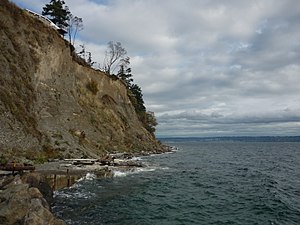Feeder bluff
This article's tone or style may not reflect the encyclopedic tone used on Wikipedia. (March 2014) |

A Feeder Bluff is a coastal cliff or headland that, through erosion and weathering, provides sediment to down-current beaches as a result of littoral drift. First discussed at Western Washington University, the term Feeder Bluff is commonly used in the Puget Sound region of the United States. [1]
A bluff will be more susceptible to erosion if the sediment is unconsolidated, and more resistant in crystalline rocks, like granite. Rocks that are heavily fractured are also very likely to suffer from erosion because the water can flow between the cracks to speed up the process. A bluff will retreat towards land as the erosion processes continue.
The term has not been extensively researched; specific criteria have not been developed to distinguish "feeder bluffs" from other types of bluffs; and quantities and rates of sediment supply to beaches and the littoral drift are unspecified and unknown. The overall contribution of "feeder bluffs" to beach processes, unlike the well-researched effects of sediment from rivers, is still undetermined.
References
- ^ "Puget Sound feeder bluff - Washington State Department of Ecology". ecology.wa.gov. Retrieved 2020-02-12.
- Easterbrook, Don J. (1999). Surface Processes and Landforms (2nd ed.). Upper Saddle River, N.J.: Prentice Hall. ISBN 978-0-13-860958-0.


